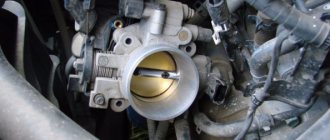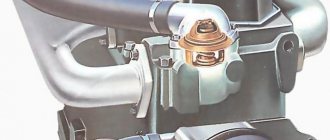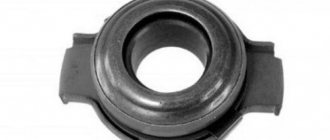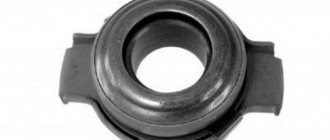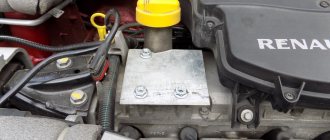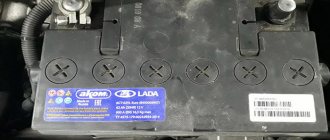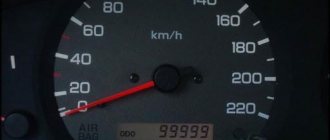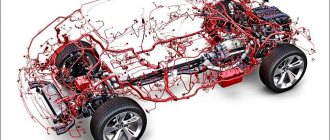Description of the most common malfunctions of car batteries: signs, causes, elimination rules. Video about the causes of battery failure.
If the car does not start, then most likely the reason for this is insufficient starting current supplied by the battery. And it’s good if you simply forgot to recharge the battery after the car was idle for a long time. In more complex cases, the battery fails and requires repair or replacement. What problems can occur with this device and how to recognize them?
Fast self-discharge
Even a serviceable battery without load can lose energy in an amount of up to 0.5% of its capacity per day. But if the battery loses up to 5 or 10% of its original charge, it’s time to sound the alarm. A sign of rapid self-discharge of the battery is the engine failure to start when the car has been idle for no more than seven days.
However, the reasons for the rapid leakage of energy from the battery may be not only its malfunction, but also problems in the vehicle’s electrical circuit itself. Or the equipment is connected incorrectly, as a result of which it continues to draw amp-hours from the battery even after the engine has been turned off.
Therefore, you should not immediately replace a dead battery with a new one. First, the suspicious battery needs to be charged and removed from the car. If the battery itself begins to quickly lose energy, then self-discharge actually occurs. The main reasons for this problem are:
- low quality electrolyte;
- electrolyte separation, in which the acid, which has a higher density compared to water, falls down the can;
- destruction of plates;
- clogging of the electrolyte with plate particles;
- contamination of battery terminals.
Cracks in the tank
Cracks in the tank are determined by traces of electrolyte leakage or by using a portable voltmeter, one wire of which is connected to any output pin, and the other touches the surface of the tank in the places of suspected cracks. The deviation of the voltmeter needle indicates the presence of cracks. The contaminated and electrolyte-filled surface of the battery is wiped with a cloth moistened with a 10% solution of ammonia or bicarbonate of soda. Clogged ventilation holes are cleaned with a wooden stick. The use of copper or iron wire for this purpose is unacceptable. Oxidized pins and clamps are cleaned with a scraper. After tightening the nuts, the clamps and pins are lubricated with technical petroleum jelly or grease.
Eliminate energy leaks
The spoiled electrolyte is replaced with a new one. The process goes something like this:
- the battery is fully charged;
- the spent electrolyte is drained from the battery;
- jars are washed with distilled water;
- A new electrolyte is poured into the battery, the density of which must correspond to the full charge of the battery.
What about a maintenance-free battery? Try to make it “serviceable” by drilling holes above the unit’s cans to fill in the electrolyte. It is advisable not to touch the plates or condensation channels. Of course, if the battery is not designed for such repairs, then it would be safer to replace it completely. But then the costs will be higher.
You can try to restore the functionality of a battery with slightly crumbled plates by washing it with distilled water. After this process, new electrolyte is poured into the battery.
A short circuit at the battery terminals can occur as a result of the formation of deposits in this place. Especially if they have also accumulated electrolyte vapors, which in this case is quite to be expected. It is better not to bring the unit to this state, but if contaminants have already formed, then it is worth rinsing the battery crankcase with a weak soda solution and then with water. Moreover, the battery should be washed with a sponge, brush or clean rag, and not bathed.
Hull damage
This problem can be detected by visual inspection of the product: leaking electrolyte will be noticeable immediately. There is another way, which involves using a tester. It needs to be switched to measuring voltage, one probe connected to any terminal of the battery, and the second probe moved along the body. A deviation of the arrow will indicate a faulty car battery. Causes of cracks:
- poor fastening of the battery, as a result of which it is subject to vibration and shaking;
- careless attitude towards the product during its transportation and storage;
- getting into an accident.
If there is mastic on top of the battery (today such batteries are outdated and quite rare) and electrolyte oozes from under it, the cracks can be eliminated by melting. The same applies to modern batteries if there is damage near the terminals (you just have to solder the plastic). But cracks on the side of the battery cannot be eliminated using this method: it will have to be sent for repair, where the case will be replaced. Independent restoration is possible only if there is minor damage and the battery is collapsible. In this case, epoxy resin comes in handy. Procedure:
- completely drain the electrolyte;
- remove the mastic from the top edges to remove the plates in the “set” with the battery electrodes;
- Dry the empty housing thoroughly;
- seal the cracks with epoxy resin using a thick cloth soaked in it;
- dry the repaired box within 24 hours;
- Fill in the electrolyte of the required density.
Electrolyte boiling
Unlike the “traditional” one, boiling of the electrolyte does not occur due to its high temperature. There are usually two reasons for excessive evaporation of the battery fluid:
- improper operation of the relay regulator, as a result of which the battery is recharged and the water in it breaks down into oxygen and hydrogen;
- sulfation of the battery plates, which does not allow them to fully interact with the electrolyte, which leads to the battery not receiving enough energy, as well as electrolysis.
In fact, the battery is not to blame for the malfunctions related to the first case. Here you just need to repair the generator or relay. But sulfation needs to be dealt with.
Write-off process
The battery is handed over to a recycling company
This is done as follows. The condition of the part being written off is checked in accordance with RD-3112199-1089-02 or the instructions in force at the enterprise. A battery write-off act is drawn up. Its sample is in RD-3112199-1089-02 in Appendix No. 3.
The battery is handed over to a recycling company. In accounting, on the basis of the write-off act, the part is written off from off-balance sheet account No. 9 and information about the new spare part is recorded on it.
Sulfation of battery plates
As in the case of self-discharge, the plates of even a healthy battery are gradually coated with lead sulfate. Another thing is that frequent and deep discharges of the battery catalyze this process, and the salts grow in such quantities that they significantly limit the contact area of the electrodes with the electrolyte. In such conditions, it would be naive to expect high performance from the battery. Some signs of battery sulfation:
- significant reduction in battery capacity;
- weak cold start current;
- Battery boils when charging.
On the Internet you can find many recommendations on how to rid battery plates of plaque, but most of these methods can permanently damage the unit. Finding a truly effective and uncomplicated way to desulfate a battery is quite difficult. So it is better to replace a battery with a large amount of salts immediately - anyway, after cleaning it will not work normally.
Sluggish and dim
You can guess that the battery is bad when starting the car. If the indicators on the panel or the interior lighting noticeably dim, and the starter barely turns the crankshaft, then the battery is clearly not itself. Of course, oxidized terminals and, say, a simple undercharging of the battery due to a negative energy balance may be to blame, but in any case, this is a reason to find out the reason for such “sluggishness.” And if the terminals are well tightened, and the travel mode allows the battery to be recharged on the road, then it may very well be that the battery is simply time to retire.
Short circuit
When the plates in one of the cans short out, the voltage in the entire battery drops to 10-10.5 V. Thus, the battery receives two volts less from the faulty container.
To identify a short-circuited can, you need to put the battery on charge and, before completing its replenishment with electricity, determine in which container the electrolyte has not boiled. There you should look for the cause of the malfunction. Typically, a short circuit occurs as a result of:
- destruction of plates caused by their wear or violation of battery operating rules;
- deformation of the battery case;
- factory defect.
A short-circuited battery should be carefully examined for swelling or damage to the case. If such problems are found, but they are not so significant, then you can try to repair the battery. In case of serious holes and large dents, the battery must be replaced.
NET.Gadget
Articles
How to check amps with a multimeter? annotation
A multimeter is a device that is used to measure voltage, current, resistance, and test wires. In other words, this device is quite necessary. With all this, as practice shows, it is quite popular not only in the industry, but also in everyday life.
Alas, once a competent installation is carried out and how to proceed with the necessary measurements, it should be taken into account that a multimeter. Not a completely safe device. If used incorrectly, of course, it will not only simply disable it, but also cause severe harm to one’s own health. This is especially true in cases where your company needs to take measurements at high voltage or high current. It won't be difficult to just immediately burn the multimeter and get severe electrical injury.
That’s why, before you can properly install and start using a multimeter, you need to practice on power sources with low current ratings, for example, batteries. It is also not recommended to misuse the instructions for the device.
Types of multimeters
First you need to know that multimeters are digital and analog (pointer, even among electricians they are known as “tseshka”). The latter have been known to electricians for a long time, but it is quite difficult to use them without special knowledge and practice.
- you need to be able to understand the scales of the device, of which there are several on the dial multimeter;
- The device should be kept in a position where the needle on it will not “walk” along the scale.
That's why, if possible, it is better to use a digital multimeter. We will also consider examples with the implementation of a specifically digital device, because it is quite difficult to learn how to work with analog multimeters without the help of others.
There are quite a few varieties of digital multimeters, but the principle of their operation is similar to each other - the difference lies solely in the number of functions of the device. Accordingly, the cost also depends on the functionality of the multimeter, so before you get it, decide why you need it.
The multimeter consists of:
- the device itself;
- 2 probes (dark and reddish);
- power source (9 V Krona battery).
So, what are the features of using this measuring device and how?
Instructions
In order to measure the current in a circuit, you need to connect the device to it one by one. With all this, on the multimeter itself you need to plug a reddish-colored probe into the socket on the device labeled mA, and a dark one into com. A serial connection means that the circuit must be broken and each probe is connected to a different wire, i.e. the device must be connected between 2 power sources. But because you are measuring current strength, and this is simply impossible to do in power supplies, you need to include a certain device in the circuit, for example an ordinary light bulb, placing it in the circuit immediately after the power source.
How can you simply check your charger
multimeter. Watch my other videos from the useful category.
Opening the battery plates
Getting rid of unwanted contact between battery plates is technically not difficult. However, such repairs rarely achieve the rated voltage at the battery terminals. And then, if the electrodes did not completely crumble and did not short-circuit everything that was possible in the battery crankcase.
Usually, if the battery plates are short-circuited, it is washed with distilled water. The cleaning method is as follows:
- The battery is half filled with distilled water;
- the battery is shaken to lift sediment from the bottom;
- the battery suddenly turns over, the water is drained;
- washing is repeated several times;
- new electrolyte is poured into the battery;
- The battery is charged in several stages, between which the electrolyte density is measured and adjusted if necessary.
In fact, when pouring distilled water into the battery, you can limit yourself to a faulty container - then it will be easier to shake the unit. If the destruction of the battery plates has not gone too far, then the crumbled particles can be washed out.
However, a battery with deformed plates, even after thorough cleaning, is unlikely to boast high performance. Well, if the battery case is damaged, washing the unit with water will be of little use.
Introduction.
A modern car cannot operate electrically without current.
With the help of an electric current, the working mixture is ignited in carburetor and gas-mixing engines, the engine is started with a starter, the light and sound alarms, control and measuring lighting, instruments and additional equipment are activated. Electric current is the directional movement of charged particles in a conductor, and the force under which an electric current occurs in conductors is called electromotive force (EMF).
electrical current sources
Such devices are called units or units that convert one type of electrical energy into energy.
To obtain electrical energy, electric current sources are installed in the car - a generator and a battery. The generator converts mechanical energy into battery energy, and the electric battery converts chemical energy into electrical energy.
which, Devices convert electrical energy into other types of energy, are called consumers.
Such lamp devices include lighting, starter, electric motors of fan, heating and cabin wiper, water temperature indicator, oil pressure in the engine and other devices.
In this work we will look at the battery, its design, application and technical maintenance.
Battery explosion
A short circuit in the battery can not only reduce the voltage at its output, but also lead to a real explosion of the device. The reasons for such an emergency could be:
- severe battery overcharging;
- short circuit when starting the engine using power cables;
- low electrolyte level.
The second scenario is possible when a negative power cable is connected between two cars, or the so-called “lighting”. In such a situation, it is enough to accidentally touch the hood or crankcase with the positive pole for the battery to spark. And oxyhydrogen gas accumulating due to low electrolyte levels in the upper part of old battery cases and oil spills in the engine compartment can cause an explosion that can rip the battery cover off.
In principle, the battery can explode without the participation of a second car. If the electrolyte level in the battery is below the plates, then when you try to start the engine, a spark that jumps in an uncovered area can make a lot of noise.
Terminal oxidation
Why do battery terminals oxidize, what are the reasons for this phenomenon? Most often this is caused by loose contact contacts to the battery poles. This can be detected by a white coating on the pole terminals, which can appear when electrolyte comes into contact with the contacts. As a result, the electrical resistance in the battery-starter circuit gradually increases. The latter begins to turn the crankshaft with difficulty due to insufficient current. To solve the problem:
- clean the terminals and terminals with fine sandpaper until a metallic shine appears;
- lubricate the contacts with special lubricant (sold in car dealerships) or technical petroleum jelly;
- tighten the terminals well (but without fanaticism!).
Polarity reversal
You still need to manage to mix up the battery contacts when connecting it to the on-board network. After all, battery terminals, just like tips, have different diameters. But if you really “want”, then you can. The consequences of such a polarity reversal will depend on the settings of the car itself.
Thus, connecting the battery with a reversal of polarity, even with the ignition off, is fraught with failure of devices that are in constant contact with the power source. This could be a stereo system, a clock, an alarm system, etc. Perhaps fuses or other protective elements will prevent serious damage, but who knows?
You can go further and activate the ignition. The on-board computer will be at risk. The battery itself is unlikely to be seriously damaged. Unless it melts a couple of wires in the car's electrical circuit.
But if you connect a reversed battery to the on-board power supply while the engine is running, you can expect a short circuit at the battery contacts. After all, a car’s generator, like a battery, will produce current, but in the opposite direction.
As a result, this method of connecting the battery will, at best, cause a failure of the relay or breakdown of the diode bridge of the generator; at worst, a breakdown of the battery, burnt out wiring, and maybe a fire in the car. Moreover, when connecting the terminals, powerful flashes are possible, so the experimenter also risks his health.
Many electronic devices in modern cars are protected against reverse current flow. But, be that as it may, such a polarity reversal will not bring anything good to the car. Therefore, it is better not to experiment and, if necessary, purchase a battery with the required polarity and connect it normally.
Conclusion
During their service, batteries encounter a variety of faults. Batteries can quickly discharge, sulfate, short out, and finally simply explode. Car enthusiasts can fix some of these problems on their own; sometimes it’s easier to replace the unit. Caring for the device consists mainly of keeping the terminals clean, and for serviced batteries, also monitoring the condition of the electrolyte. Yes, and when connecting the power source to the on-board network, the polarity should still be observed.
Video about the causes of battery failure:
Monoblock malfunctions
Malfunctions of monoblocks occur in the form of cracks, chips, holes, which appear as a result of impacts, shaking and careless handling. Plastic monoblocks are most susceptible to mechanical damage, especially at low temperatures. Cracks in the tank partitions cause a short circuit through the electrolyte of opposite plates of adjacent batteries, connected to each other by an intercell jumper. The plates are discharged, and the density of the electrolyte in tanks with a crack in the partition will be less than in the others, and the total EMF of two batteries closed with electrolyte will be the same as the EMF of one serviceable battery.
The presence of a crack in the monoblock wall or in the partition can be easily detected if a weak electrolyte solution is poured on both sides of the partition being tested 10...15 mm below its upper edges and opposite battery plates are placed, connected to each other through a voltmeter. The deviation of the instrument needle indicates the presence of a crack in the partition.
PROBLEM – BATTERY IS DYING
1. Check the integrity of the generator drive belt. If it is damaged, replace it. If the belt is intact, check its tension by pressing on it with your thumb. The deflection should not exceed 1.5 cm; if necessary, the belt tension must be adjusted.
2. Check the generator. If a malfunction is detected, send it for repair.
3. Check the electrical equipment system for damage to the insulation of current-carrying elements. Find damage and isolate.
The battery is discharged if the current does not flow through the generator into the vehicle's on-board network, then the battery's charge is consumed. A malfunction is indicated by a red battery charging lamp on the dashboard.
4. The reason that the batteries are quickly discharged may be the installation of new electrical equipment on the car that is not provided for in the diagram; in this case, if you turn off additional electrical equipment, the problem will be eliminated.
5. Check the condition of the battery. If its body is very dirty, it is necessary to clean it and the lid from dirt with a soft cloth with soda water or an aqueous solution of ammonia.
6. The entry of foreign impurities into the electrolyte can cause this malfunction. In this case, you must first recharge the battery, then drain the old electrolyte, rinse the batteries, add new fluid and recharge the device.
7. Check the electrolyte level. If it drops below the permissible limit (the level of the upper plate), add distilled water until the required level is restored.
8. If the reason for battery discharge is a short circuit, it is necessary to replace the batteries with new ones.
PROBLEM – ELECTROLYTE SPLASHING OUT OF THE BATTERY
1. Check whether the upper permissible electrolyte level in the batteries is exceeded. Adjust it if necessary.
2. Check the integrity of the housing. The appearance of cracks and damage may cause electrolyte leakage - in this case, the battery must be replaced.
3. Check the generator voltage regulator. If the voltage is too high, the electrolyte will boil and may splash out of the battery. If the part is faulty, replace the regulator with a new one.
4. If the voltage regulator is in good condition, but the battery gets very hot and the electrolyte boils, you need to check the battery plates. Their sulfation may cause liquid to splash out of the case; in this case, the batteries must be replaced.
Oxidation of terminals
Oxidation of the pole terminals leads to an increase in resistance in the external circuit and even a stoppage of current. To eliminate the malfunction, you need to clean the leads to a metallic shine and fasten them to the pins. After this, lubricate the pins and terminals on the outside with a thin layer of VTV-1 technical petroleum jelly or other acid-resistant lubricant.
Increased self-discharge
Increased self-discharge of the battery can be caused by the following reasons: 1. internal short circuit; 2. contamination of the battery surface; 3. use for topping up undistilled water containing alkalis and salts; 4. ingestion of metal particles and other substances that promote the formation of galvanic couples.
Self-discharge of the battery occurs due to the formation of local currents in the active mass of the plates, which appear due to the occurrence of EMF between the oxides of the active mass and the lattice of the plates. In addition, during long-term storage, the electrolyte in the battery settles, and its density in the lower layers becomes greater than in the upper ones. This leads to the appearance of a potential difference and the appearance of equalizing currents on the surface of the plates. The normal self-discharge of a serviceable, fully charged, maintenance-free battery is 0.2–0.3% per day.
Short circuit
A short circuit of opposite plates is accompanied by “boiling” of the electrolyte, a decrease in the capacity and voltage of the battery. The reasons for this may be: destruction of the separators, warping of the plates, loss of the active mass from them, which entails frequent recharging of the battery and increased vibration due to loosening of the fasteners. In this case, the battery must be replaced.
Contamination of lids and mastic
Contamination causes oxidation of the terminals and discharge of the batteries. Dust and dirt become saturated with electrolyte, which shorts the terminals and the battery discharges. To detect current leakage, connect a voltmeter to the surface of the mastic (covers). If it registers voltage, then it is necessary to clean the surface of the battery from dust, dirt and electrolyte and wipe the covers with a 10% aqueous solution of ammonia or soda and wipe dry.
Cracks in mastic, lids and tank
Cracks occur due to aging of the mastic, as well as due to vibration of the battery when it is not securely fastened. Cracks in the mastic and caps, as well as loose fitting of the filler plugs, cause electrolyte to splash onto the surface of the caps; the electrolyte shorts the terminals, which causes the batteries to discharge. Small cracks in the mastic are repaired by melting. Severely cracked mastic is replaced. If there are cracks in the covers and tank, the battery is repaired in a specialized workshop (parts are replaced).
Electrolyte leakage
Electrolyte leakage through cracks in the housing is detected visually. Most often, cracks appear near the battery terminals due to careless removal of the terminals, and can also occur due to mechanical damage to the housing (usually during accidents). A small crack in the plastic case of the battery can be repaired by melting it with a piece of polyethylene using a soldering iron, or by placing several layers of plastic film over the crack and melting them through a sheet of thick paper. If the housing is significantly damaged, the battery must be replaced. If you are forced to temporarily operate a faulty battery, you must periodically add electrolyte to it, not distilled water.
Oxidation of leads and tips of starter wires
Oxidation is accelerated by contact with electrolyte, lack of lubricant, and loose terminals. This increases the resistance of the external circuit. Oxidized terminals should be cleaned and lubricated. You need to check the electrolyte level with a glass tube, plastic or wooden rod (at least every 10-15 days, and even more often in the hot season). The electrolyte level should be 10-15 mm above the safety shield (for 6ST-55 type batteries - 5-10 mm). When the electrolyte level drops, add only distilled water. To mix water with electrolyte, the battery is recharged for 10-15 minutes. On a car, add water while the engine is running.
Reduced or increased electrolyte density
The density of the electrolyte decreases mainly when the batteries are discharged and the electrodes are sulfated. As the density of the electrolyte decreases, the internal resistance of the battery increases and its capacity decreases. As a result, the voltage in the operating starter circuit drops, the armature rotation speed and starter power decrease, which makes starting the engine difficult, especially in the winter. In addition, in winter the electrolyte may freeze.
The density of the electrolyte increases when water evaporates during recharging or as a result of adding electrolyte rather than water to the batteries. In the case of increased electrolyte density, the destruction of the active substance and electrode grids, as well as sulfation of the active substance, is accelerated, which reduces the capacity and service life of the battery. The density of the electrolyte in the batteries should not differ by more than 0.01 g/cm3. Otherwise, the battery must be charged and the electrolyte density adjusted by adding water or electrolyte to the batteries. If the density is higher than normal. - add water, if below - electrolyte with a density of 1.4 g/cm3. Topping up is carried out after preliminary selection of the required amount of electrolyte from the batteries. After this, the battery is charged for 25-30 minutes to completely mix the electrolyte and its density is measured again. The density of the electrolyte in the battery cells indicates the degree of discharge of the batteries. A decrease in electrolyte density by 0.01 g/cm3 corresponds to a battery discharge of 6%.
Sulfation of electrodes
Sulfation of electrodes consists of the formation of large, poorly soluble crystals of lead sulfate (sulfate) on the surface of the electrodes and on the pore walls of the active substance. Sulfate crystals clog the pores of the active substance of the electrodes, which prevents the electrolyte from penetrating deep into the active substance. As a result, not all the active substance is involved in the work, which reduces the capacity of the battery. Sulfation of electrodes is accelerated by long-term storage of the battery without recharging, increased electrolyte density, high vacuum, and interaction of electrodes with air at a reduced electrolyte level. Due to its low capacity, a sulphated battery discharges quickly when the voltage drops sharply, especially when the starter is turned on.
When charging a sulfated battery, the voltage and temperature of the electrolyte quickly increase, and intense gas evolution begins, while the density of the electrolyte increases slightly, since part of the sulfuric acid remains bound in the sulfate. Sulfation of electrodes is determined by comparing the EMF calculated from the density of the electrolyte with the voltage measured using a voltmeter without load. If the voltage is greater than the EMF calculated by density, the battery electrodes are sulfated.
Sulfation is eliminated by discharging and charging the battery several times at a low electrolyte density (1.11 - 1.12 g/cm3). When charging, the electrical charge should not exceed 5% of the rated capacity of the battery. Then a control discharge is carried out equal to 10% of the nominal battery capacity. The current in the circuit is controlled by a rheostat. When the voltage at the terminals of the worst battery drops to 1.7 V, the discharge is completed. The battery is considered to be in good condition if the discharge time is at least 7.5 hours for a battery with an electrolyte density of 1.29 g/cm3, 6.5 hours with an electrolyte density of 1.27 g/cm3 and 5.5 hours with an electrolyte density of 1.25 g/cm3.
If the battery discharge time is less than the specified values, then it is subjected to several charge-discharge cycles, controlling the discharge time. If repeated discharges do not increase the discharge time, then such a battery requires repair. Test discharge is also carried out to determine the suitability of batteries for further use and before long-term storage.
Premature destruction of electrodes
During the operation of the battery, oxidation of the grids and loosening of the active substance, especially the positive electrodes, occurs. Changes in the volume of the active substance when charging and discharging the battery cause it to peel off from the grids. During operation, other reasons may arise that lead to accelerated destruction of the electrodes. These are unstable fastening of the batteries on the car, long-term recharging of the battery, freezing of water in the electrolyte, lowering of the electrolyte level below the upper edges of the electrodes, short circuit, incompetent starting of the engine with the starter, etc.
A short circuit, as well as frequent and prolonged activation of the starter, leads to warping of the electrodes, which accelerates the destruction of the mass of the active substance, especially the positive electrodes. The starter should be turned on for no more than 5 seconds and no more than two or three times in a row. It is recommended to pause for 15-20 seconds between switching on. The destruction of electrodes accelerates with increasing density and temperature of the electrolyte, the use of chemically impure sulfuric acid and undistilled water. When the battery is recharged for a long time, electrolysis of the electrolyte water occurs into oxygen and hydrogen. Oxygen strongly oxidizes the grids of the positive electrodes, which causes their destruction. At the same time, a large amount of gases (oxygen and hydrogen) accumulates in the pores of the active substance of the electrodes. The gas pressure in the pores increases, which causes loosening and chipping of the active substance. A characteristic sign of overcharging is strong gas release from the electrolyte and a rapid decrease in its level. To avoid overcharging the vehicle batteries, it is necessary to systematically check the alternator voltage.
The destruction of the electrodes causes a decrease in the capacity of the batteries and a short circuit of opposite electrodes. In batteries with damaged electrodes, even if they are fully charged and free of sulfation, the voltage under load (especially starter) will drop quickly. Voltage measurement under load close to starter load. allows you to check the performance of the battery. The voltage of the battery is measured by the E107 probe, and that of the batteries by the E108 probe or the LE2 load plug. The voltage change under load is carried out with the battery plugs wrapped, which prevents the possibility of an explosion of the hydrogen-oxygen mixture.
The E107 battery tester allows you to check the performance of batteries with a capacity of up to 190 Ah with hidden inter-battery jumpers. If the voltage at the end of the fifth second of connecting the probe is more than 8.9 V, then such a battery is in good condition.
The battery is the main component of a car's electrical system. Without it, it is impossible to start the engine. Like other parts, it wears out over time and stops working. This article will tell you what battery malfunctions are, why they appear, how to detect and fix them.
